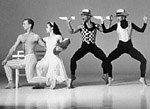IF YOU WATCH DANCING long enough, eventually the stage becomes filled with ghosts, as the dancers in front of you are joined by your memories of their predecessors. In the case of the Paul Taylor Dance Company, which performed here last week as part of the Meany Hall World Dance Series, the current members are on stage with some illustrious companions.
Paul Taylor Dance Company
UW campus, Meany Hall, October 21
“Cascade” reads like a glossary, Taylor-style: space-devouring leaps, weighted jumps rocking side to side, deeply flexed lunges, and plummeting drops to the floor, all in a combination of fleetness and power that is beautiful without necessarily being pretty. Taylor is always able to find the motor in baroque music, in this case familiar excerpts from Bach concerti, but doesn’t get tied up in its mannerly heritage. The dancers are courteous, in period-influenced costumes by Santo Loquasto, but they aren’t fragile. In a series of propulsive jumps they hurtle through the air, leading with their chests, their arms and legs flung back. Taylor appears to be looking back on his repertory here, especially “Aureole” and “Esplanade,” and seems to actually quote from them in this new work.
Taylor has said that in “Eventide,” a series of duets set to music by Ralph Vaughan Williams, he tried to see how little dance movement he could put in a work and still have it read as a dance, but this experiment in subtlety ends up beings too low-key. Although it features skilled performances, especially by Francie Huber and Patrick Corbin, the sweetness of the score and the backdrop image (trees at sunset verging on a greeting card illustration) wipe out most of their dynamic shifts, leaving an undifferentiated prettiness.
In the case of “Le Sacre du Printemps (The Rehearsal)” Taylor is dealing with a score that comes with massive amounts of baggage. Since its scandalous premiere in 1913, precipitating a riot in the auditorium and countless anecdotes, “Sacre” has posed a daunting set of challenges for choreographers, starting with a rhythmic structure so complex that Vaslav Nijinsky, its original choreographer, was reduced to yelling out the counts to his dancers from backstage on opening night.
Taylor began his career with a series of rebellious and quirky dances, and though he is now enthusiastically accepted by the mainstream, he still works with his tongue in his cheek occasionally. In his version of “Sacre” he starts by turning his back on the original scenario (a prehistoric community sacrifices a virgin to ensure the return of spring) and instead combines images from old gangster films with mordant scenes of life in a dance company: taking class, rehearsing, getting paid. As the two worlds blend (gangsters warming up at the barre and dancers shaking each other down for their cash), allusions to other productions of “Sacre” emerge. Taylor appears to be flirting with historical iconography and with the expectations of the audience. Finally, after a deadpan sequence of multiple murders, it seems like the heroine is actually going to dance herself to death, in line with the original story, but halfway through the solo a mirror is lowered down behind her and the cast reenters the stage to dance the wrenching choreography in unison. Just when we think Taylor has decided to finish them all off together, they fade away, leaving the “virgin” to “die” alone on the last note of the score. Taylor has piled image on image, combining erudite dance history and popular culture, then pulled a sequence of rugs out from underneath us, so that we’re not sure where it ends until we get there.
In this revival of the 1981 work, some of these jokes are less telling than others, particularly the role of the Rehearsal Mistress, originally made for Taylor’s actual rehearsal director Bette de Jong, whose considerable height was enhanced by high-heeled boots and an improbably tall shako hat. The bumbling policemen and oily henchmen could all be a bit more broadly played as well, though Andrew Asnes’ noble and dumb interpretation of the Private Eye matched his horn-rimmed glasses perfectly. But though the current cast is still working towards erasing my memories of the original group, they are certainly dancing in good company.








